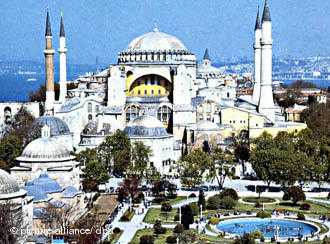A place of worship over centuries, the Hagia Sophia in Istanbul draws millions of visitors each year. Now there could be even more interest with a new, and yet old, attraction that provides insight into early baptisms.
The Hagia Sophia in Istanbul served as a church for a millennium and as a mosque for another 500 years.
 Today it is a museum that attracts three million visitors annually, with the number of tourists rising significantly in recent years. The number is expected to rise still further after an addition to its attractions was unveiled this week.
Today it is a museum that attracts three million visitors annually, with the number of tourists rising significantly in recent years. The number is expected to rise still further after an addition to its attractions was unveiled this week.
As a grand finale to its year as European capital of culture, Istanbul has unearthed the original baptismal font of the ancient church.
The huge marble basin sits in the courtyard of the baptistry, where it had been buried underground for centuries. The font had not been seen since the Ottoman conquest of Constantinople in 1453, the director of the Hagia Sophia museum Haluk Dursun told Deutsche Welle.
“We are the first to see this baptismal font since the days of Sultan Mehmet the Conqueror,” Dursun said. “The Ottomans initially used the baptistry to store oil for the lamps in the Hagia Sophia, which they had converted to a mosque.”
“The font was forgotten in some corner of the warehouse. Later, they converted the baptistry into a tomb for minor sultans and moved the basin out into the courtyard, which was then filled in with the surplus soil from the burials.”
Because the font – thought by Dursun to be older than the Hagia Sophia building – was buried under the earth, it remains in remarkably good condition. Its white marble has been rendered smooth and bright after a thorough cleaning.
Older than church itself
The Hagia Sophia was inaugurated in the year 532 and the font may have belonged to one of the earlier churches on the site, built in the fourth and fifth centuries and destroyed by fire.
The font, the size of a small car, is believed to be the largest of its kind and is hewn from a single block of marble that is 3.3 meters (11 feet) in length, 2.5 meters wide and 1.5 meters high.
Visible steps on the inside walls of the basin reveal that it was probably used for mass baptisms Dursun said.
“On its front side, the font was originally decorated with gem-encrusted crosses,” said Dursun. “Those were unfortunately carried off by the knights of the Fourth Crusade when they pillaged the church in the 13th century. At least we can still see their outlines here.”
Not going anywhere
Despite the renewed interest, the font of the Hagia Sophia will not be moving to take pride of place at the Hagia Sophia museum. It will instead be displayed to visitors in its present resting place in the courtyard, rather than in its original place under the dome of the baptistery.
Among other reasons, there are fears that it would be impossible to move the font without it being destroyed.
“When the baptistery was converted into a tomb in 1639, the baptismal font was lifted out of this window and set down in this place without it toppling over or breaking,” said Dursun. “This was an amazing feat in my opinion. We would have trouble lifting it today.”
It is hoped that the font will be open to public viewing by Easter.
Author: Susanne Guesten, Istanbul (rc)
Editor: Chuck Penfold
via Istanbul font provides link to early Christianity | Culture & Lifestyle | Deutsche Welle | 17.12.2010.

Leave a Reply